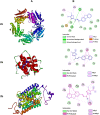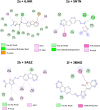Design, synthesis, molecular docking, and dynamics studies of novel thiazole-Schiff base derivatives containing a fluorene moiety and the assessment of their antimicrobial and antioxidant activity
- PMID: 39497776
- PMCID: PMC11533417
- DOI: 10.1039/d4ra04197f
Design, synthesis, molecular docking, and dynamics studies of novel thiazole-Schiff base derivatives containing a fluorene moiety and the assessment of their antimicrobial and antioxidant activity
Abstract
In this study, a series of eighteen fluorene-containing substituted thiazole derivatives were synthesized and characterized via spectral analyses. The proposed compounds were screened for their in vitro antimicrobial activity, and it was found that compound 2a displayed a significant zone of inhibition (20.3 ± 0.6 mm) against B. subtilis and compound 2b exhibited inhibitory activity (30.3 ± 0.6 mm) against a C. albicans fungal strain. Furthermore, antioxidant activity was evaluated for all analogues, where 2f exhibited a four-fold higher antioxidant capability (11.73 ± 1.22 μg mL-1) than the standard ascorbic acid. Oral bioavailability and toxicological parameters were considered, and most of the compounds satisfied Lipinski's rule of five and Veber's rule, except for one violation by a few derivatives. Molecular docking and molecular dynamics simulation were performed, providing more explicit ideas on the binding interaction and stability of compounds that exhibited wet lab activity. Average RMSD and RMSF values ranged between 0.5 Å and 2.5 Å, which indicated the stability of ligands inside the complex, yielding some engrossing insights.
This journal is © The Royal Society of Chemistry.
Conflict of interest statement
The authors declare that there is no conflict of interest.
Figures













Similar articles
-
Synthesis, antibacterial activity, in silico ADMET prediction, docking, and molecular dynamics studies of substituted phenyl and furan ring containing thiazole Schiff base derivatives.PLoS One. 2025 Mar 10;20(3):e0318999. doi: 10.1371/journal.pone.0318999. eCollection 2025. PLoS One. 2025. PMID: 40063584 Free PMC article.
-
Synthesis, Biological Evaluation, in Silico ADMET Prediction, Molecular Docking and Dynamics Studies of 4-phenoxyphenyl-thiazole-Schiff Base Derivatives.J Biochem Mol Toxicol. 2025 Jun;39(6):e70362. doi: 10.1002/jbt.70362. J Biochem Mol Toxicol. 2025. PMID: 40522201
-
In vitro and in vivo evaluation of the antimicrobial, antioxidant, cytotoxic, hemolytic activities and in silico POM/DFT/DNA-binding and pharmacokinetic analyses of new sulfonamide bearing thiazolidin-4-ones.J Biomol Struct Dyn. 2024 Apr;42(7):3747-3763. doi: 10.1080/07391102.2023.2226713. Epub 2023 Jul 4. J Biomol Struct Dyn. 2024. PMID: 37402503
-
Synthesis, Biological Properties, In Silico ADME, Molecular Docking Studies, and FMO Analysis of Chalcone Derivatives as Promising Antioxidant and Antimicrobial Agents.ACS Omega. 2025 Jan 28;10(5):4367-4387. doi: 10.1021/acsomega.4c06897. eCollection 2025 Feb 11. ACS Omega. 2025. PMID: 39959036 Free PMC article.
-
Synthesis, In silico Molecular Docking and Pharmacokinetic Studies, In vitro Antimycobacterial and Antimicrobial Studies of New Imidozolones Clubbed with Thiazolidinedione.Curr Comput Aided Drug Des. 2018;14(4):269-283. doi: 10.2174/1573409914666180516113552. Curr Comput Aided Drug Des. 2018. PMID: 29766819
Cited by
-
Preparation, Spectral Characterization and Antioxidant Activities of Aminothiophene-Containing Schiff Base and Co(II) and Pd(II) Complexes.J Biochem Mol Toxicol. 2025 Mar;39(3):e70215. doi: 10.1002/jbt.70215. J Biochem Mol Toxicol. 2025. PMID: 40066706 Free PMC article.
-
Synthesis, antibacterial activity, in silico ADMET prediction, docking, and molecular dynamics studies of substituted phenyl and furan ring containing thiazole Schiff base derivatives.PLoS One. 2025 Mar 10;20(3):e0318999. doi: 10.1371/journal.pone.0318999. eCollection 2025. PLoS One. 2025. PMID: 40063584 Free PMC article.
-
Green procedures for synthesizing potential hNMDA receptor allosteric modulators through reduction and one-pot reductive acetylation of nitro(hetero)arenes using a superparamagnetic Fe3O4@APTMS@Cp2ZrCl x (x = 0, 1, 2) nanocatalyst.Nanoscale Adv. 2025 Mar 10;7(9):2528-2553. doi: 10.1039/d4na00882k. eCollection 2025 Apr 29. Nanoscale Adv. 2025. PMID: 40070439 Free PMC article.
References
-
- Kaboré M. Konaté I. Cissoko Y. Guindo I. Coulibaly B. Hermine M. Oumar A. A. Soumaré M. Fofana A. Zaré A. Cissé M. A. Sogoba D. Magassouba O. Issa H. H. Dao F. S. Microbiological Assessment and Antimicrobials' Use in an Infectious Diseases Department in Mali. J. Adv. Microbiol. 2021;11:8. doi: 10.4236/aim.2021.118029. - DOI
LinkOut - more resources
Full Text Sources
Miscellaneous

